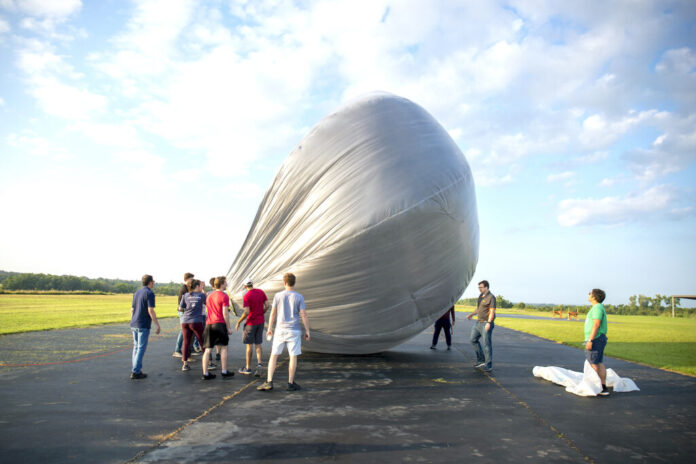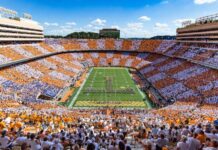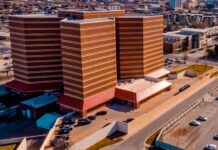By Darla Shelden, City Sentinel Senior Reporter
STILLWATER — Students from Oklahoma State University are working with NASA on ways to answer some of the unsolved questions about the conditions on Venus, Earth’s sister planet.
One of the brightest objects in the night sky, Venus is about 400 miles smaller in diameter then the Earth.
With a thick cloud cover and extremely dense atmosphere, the surface of Venus has always been a mystery.
“Early astronomers looking at Venus saw this hazy cloud over it and thought, ‘Ahh, what we are going to see is tons of jungles because it is closer to the sun,’” said Dr. Jamey Jacob, professor of mechanical and aerospace engineering and director of the Unmanned Systems Research Institute.
“They were right in concluding that Venus was hot but were unaware of just how hot — so hot that it melts lead on the surface.”
In the 1980s and early 1990s, a breakthrough was made when the U.S. spacecraft Magellan was able to map the surface. Long considered to be home to immense vegetation because of its atmosphere, the images showed an almost barren land with volcanoes and surface temperatures exceeding 800 degrees Fahrenheit.
Because most surface technology can’t withstand the heat of Venus, space exploration looked toward the planet Mars. Most planetary exploration missions in the last three decades have focused on Earth’s other neighbor, the “red planet.”
Under Mars’ cold climate and desert-like atmosphere, rovers have been able to collect immense data from the surface. However, with some advances in technology and outside-the-box thinking, studying Venus has become more viable.
Danny Bowman, a geophysicist for Sandia National Laboratories in New Mexico, designed a balloon a few years ago made out of a plastic material similar to those used for trash bags. These solar-powered balloons attached to a string that held a seismometer encased in a plastic foam box.
The seismometer’s purpose was to detect earthquakes through sounds below the level of human hearing, or infrasound.
After successful tests in California, Sandia and NASA’s Jet Propulsion Laboratory began looking for places that had multiple earthquakes a day of a smaller scale and determined that Oklahoma would be a perfect testing ground.
“The earthquake, when it shakes the ground, it acts like a giant speaker. It produces that low-frequency sound,” said Dr. Brain Elbing, an associate professor of mechanical and aerospace engineering at OSU. “The goal here is that we are going to fly a bunch of balloons with these sensors on them.
“We are trying to get natural earthquakes so it is going to be a long campaign where we are flying and waiting for earthquakes,’ Elbing said. “If we can detect a weak earthquake here, it will be easy on Venus. Looking at the propagated sound that gets in the atmosphere, we can get a good look at the structure on Venus.”
Jacob and Elbing have been working with students on testing smaller six-meter balloons with success so when Sandia and NASA JPL visited OSU in late July, it was then that they began to test the bigger seven-meter balloons, similar to the ones that Bowman had been using in California.
On the morning of July 20, at the OSU Unmanned Aircraft Flight Station near Glencoe, Oklahoma, the OSU and NASA researchers took the first steps toward a better understanding of Venus.
NASA JPL had three visitors on hand for the launch, including Siddharth Krishnamoorthy, Leo Martire and Michael Pauken, as well as Fransiska Dannemann Dugick from Sandia.
OSU is the only university participating in this project.
After some trial and error, and challenges from Oklahoma winds, the balloon successfully launched. Elbing said it would travel on the wind and land around dusk, most likely in New Mexico or Texas.
“The idea is they are lightweight and balance themselves, so they basically climb to 20 kilometers [over 65,000 feet] in the air and just stay up there all day long until sunset at that elevation,” Elbing said.
The team launched a few more balloons while the NASA and Sandia visitors were on campus. OSU students described it as a once-in-a-lifetime experience to work alongside those top-tier aerospace engineering professionals, the press release stated.
“It is nice to see the information we are learning applied to a real-life situation,” said Taylor Swaim, an OSU engineering graduate student from Tulsa. “It is also nice working alongside professionals. They are where we are trying to go as grad students or undergrad students and are definitely big role models to us.”
Dr. Jacob added, “Embarking on what will most likely be a decade-long project is exciting.”
Researchers hope the balloons will prove successful in detecting the earthquakes, and, eventually, helping to map the surface of Venus. Since the planet can’t be mapped from the ground, the sky is the best option. And Venus’ Earth-like upper atmosphere is playing to researchers’ advantage.
“So that makes it a much easier atmosphere to work in,” Jacob said. “Rather than be in the really hellish atmosphere that you have down on the surface at 600 degrees Celsius and 90 atmospheres’ worth of pressure, you are going to be relatively balmy, and that is a great environment for operating science payloads and experiments.”
Studies show, exploration of Venus is becoming a top priority for NASA. Researchers hope to learn not just about the possibility of sustaining life on Venus, but also to study the effects of climate change on a planet similar to Earth.
“Venus is exhibiting a runaway greenhouse gas scenario where you have a lot of C02 in the atmosphere and cloud cover,” Jacob said. “Venus is a lot hotter in the atmosphere than it should be, just based on the amount of solar radiation that you have coming in. Understanding that helps us understand our own planet a little better and the implications of increasing greenhouse gases on Earth and how that may affect the climate here.”
The next two missions to Venus are VERITAS and DAVINCI+, both planned for between 2028 and 2030.
The balloons probably won’t be ready to go on those missions, but with more testing at OSU, NASA JPL might be able to help uncover the mysteries of Venus sooner than previously thought possible, according to the press release.
“The JPL science team was extremely impressed with the students we had here and the job they did,” Jacob said. “They are blown away by their professionalism and capabilities. The most premier space science organization in the world coming out and visiting your facilities and leaving happy with what they see is great.”
For more information, click here.




















